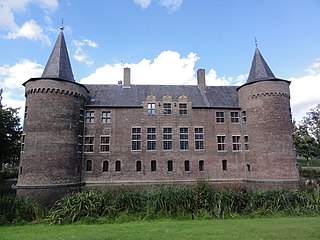Related Research Articles

Tilburg is a city and municipality in the Netherlands, in the southern province of North Brabant. With a population of 222,601, it is the second-largest city or municipality in North Brabant after Eindhoven and the seventh-largest in the Netherlands.

Willem-Alexander is King of the Netherlands.

Helmond is a city and municipality in the Metropoolregio Eindhoven of the province of North Brabant in the Southern Netherlands.

Tynaarlo is a village and municipality in the Northeastern Netherlands. Although it is located in the province of Drenthe, many of its communities serve as suburbs of the neighbouring city of Groningen, capital of the eponymous province. In 2019, the municipality of Tynaarlo had a population of 33,698.

Bussum is a commuter town and former municipality in the Gooi region in the south east of the province of North Holland in the Netherlands near Hilversum. Since 2016, Bussum has been part of the new municipality of Gooise Meren.

Hoorn is a city and municipality in the northwest of the Netherlands, in the province of North Holland. It is the largest town and the traditional capital of the region of West Friesland. Hoorn is located on the Markermeer, 20 kilometers (12 mi) east of Alkmaar and 35 kilometers (22 mi) north of Amsterdam. The municipality has just over 73,000 inhabitants and a land area of 20.38 km2 (7.87 sq mi), making it the third most densely populated municipality in North Holland after Haarlem and Amsterdam. Apart from the city of Hoorn, the municipality includes the villages of Blokker and Zwaag, as well as parts of the hamlets De Bangert, De Hulk and Munnickaij.

Moers is a German city on the western bank of the Rhine, close to Duisburg. Moers belongs to the district of Wesel.

Daniel is a masculine given name and a surname of Hebrew origin. It means "God is my judge" and derives from two early biblical figures, primary among them Daniel from the Book of Daniel. It is a common given name for males and also used as a surname, regularly the basis for various derived given names and surnames.
The masculine given name Sander is a variant of Alexander, used in the Dutch-speaking areas of Europe, as well as Norway and Estonia. As of 1 January 2021, it is the 34th most common masculine given name in Estonia. The feminine version is Sandra; there is another masculine version in some countries: Sandro.
Willemijn Margaretha Duyster is a former Dutch field hockey defender, who played 87 international matches for the Dutch national team, in which she scored no goals.
Germanic given names are traditionally dithematic; that is, they are formed from two elements, by joining a prefix and a suffix. For example, King Æþelred's name was derived from æþele, meaning "noble", and ræd, meaning "counsel".
Shane is mainly a masculine given name. It is an anglicized version of the Irish name Séaghan/Séan, which itself is cognate to the name John. Shane comes from the way the name Seán is pronounced in the Ulster dialect of the Irish language, as opposed to Shaun or Shawn.
Nedvěd is a Czech surname. It is an old variant of the Czech word Medvěd, which means 'bear'.
Gaël is a Breton given name. Its etymology is uncertain, it may be related to the ethnonym Gael (Goidel); alternatively, it may be a variant of the name Gwenhael.
Ronja is a feminine given name in use largely in Scandinavian countries. It became widely known when the Swedish author Astrid Lindgren wrote her 1981 children's book Ronja Rövardotter. In the English translation of the book the name was translated as Ronia. It may also be translated as Ronya.

The Nijmegen Helmet is a Roman cavalry sports helmet from the first or second century AD. It was found around 1915 in a gravel bed on the left bank of the Waal river, near the Dutch city of Nijmegen. The helmet would have been worn by the élite Roman cavalry. The head portion of the helmet is made of iron, while the mask and diadem are of bronze or brass. The helmet provides neck protection via a projecting rim overlaid with a thin bronze covering plated with silver. The diadem features two male and three female figures.
Duyster is a Dutch surname. Notable people with the surname include:

Willemijn Bos is a Dutch field hockey defender. In 2011, she was included to the All-Star team by the International Hockey Federation. She was to be selected for the 2012 Summer Olympics but tore her anterior cruciate ligament during a friendly against the United States three days before the Games and had to withdraw. She returned to competitions in March 2013, and won a silver medal at the 2016 Rio Olympics.
Ji, also spelled Jee, Chi, or Chee, is a Korean family name, as well as a popular element in Korean given names. The meaning differs based on the hanja used to write it.

Gooise Meren is a municipality in the province of North Holland, the Netherlands. It has about 58,000 inhabitants and covers an area of about 77 km2 (30 sq mi).
References
- ↑ "Willemijn". behindthename.com. Archived from the original on 2021-07-31. Retrieved 2021-12-30.
- ↑ "Herkomst en betekenis Willemijn". 24 Baby (in Dutch). Archived from the original on 2022-01-17. Retrieved 2022-01-17.
- ↑ "Related Names". behindthename.com. Archived from the original on 2021-12-30. Retrieved 2022-01-17.
- ↑ "Willemijn". Archived from the original on 18 January 2022. Retrieved 18 January 2022.
- "Willemijn". Nameslist. Archived from the original on 2022-01-18. Retrieved 2022-01-18.
- "Willemijn". Namespedia. Archived from the original on 2022-01-18. Retrieved 2022-01-18.